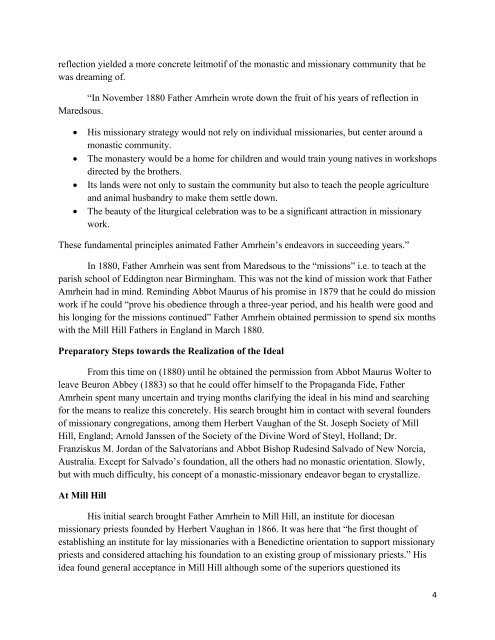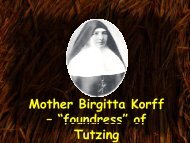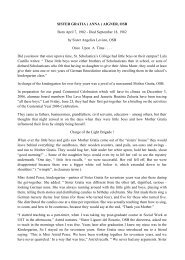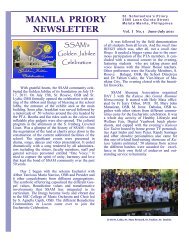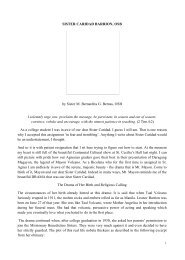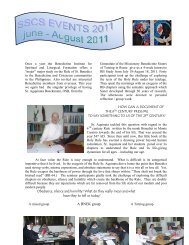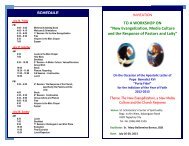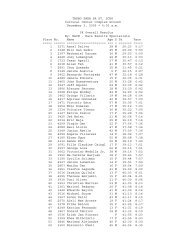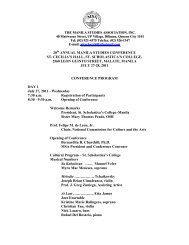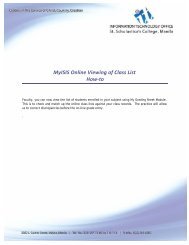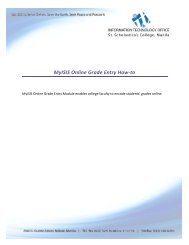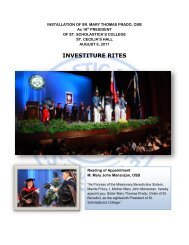Fr. Andreas Amrhein, OSB - St. Scholastica's College
Fr. Andreas Amrhein, OSB - St. Scholastica's College
Fr. Andreas Amrhein, OSB - St. Scholastica's College
Create successful ePaper yourself
Turn your PDF publications into a flip-book with our unique Google optimized e-Paper software.
eflection yielded a more concrete leitmotif of the monastic and missionary community that he<br />
was dreaming of.<br />
“In November 1880 Father <strong>Amrhein</strong> wrote down the fruit of his years of reflection in<br />
Maredsous.<br />
• His missionary strategy would not rely on individual missionaries, but center around a<br />
monastic community.<br />
• The monastery would be a home for children and would train young natives in workshops<br />
directed by the brothers.<br />
• Its lands were not only to sustain the community but also to teach the people agriculture<br />
and animal husbandry to make them settle down.<br />
• The beauty of the liturgical celebration was to be a significant attraction in missionary<br />
work.<br />
These fundamental principles animated Father <strong>Amrhein</strong>’s endeavors in succeeding years.”<br />
In 1880, Father <strong>Amrhein</strong> was sent from Maredsous to the “missions” i.e. to teach at the<br />
parish school of Eddington near Birmingham. This was not the kind of mission work that Father<br />
<strong>Amrhein</strong> had in mind. Reminding Abbot Maurus of his promise in 1879 that he could do mission<br />
work if he could “prove his obedience through a three-year period, and his health were good and<br />
his longing for the missions continued” Father <strong>Amrhein</strong> obtained permission to spend six months<br />
with the Mill Hill Fathers in England in March 1880.<br />
Preparatory <strong>St</strong>eps towards the Realization of the Ideal<br />
<strong>Fr</strong>om this time on (1880) until he obtained the permission from Abbot Maurus Wolter to<br />
leave Beuron Abbey (1883) so that he could offer himself to the Propaganda Fide, Father<br />
<strong>Amrhein</strong> spent many uncertain and trying months clarifying the ideal in his mind and searching<br />
for the means to realize this concretely. His search brought him in contact with several founders<br />
of missionary congregations, among them Herbert Vaughan of the <strong>St</strong>. Joseph Society of Mill<br />
Hill, England; Arnold Janssen of the Society of the Divine Word of <strong>St</strong>eyl, Holland; Dr.<br />
<strong>Fr</strong>anziskus M. Jordan of the Salvatorians and Abbot Bishop Rudesind Salvado of New Norcia,<br />
Australia. Except for Salvado’s foundation, all the others had no monastic orientation. Slowly,<br />
but with much difficulty, his concept of a monastic-missionary endeavor began to crystallize.<br />
At Mill Hill<br />
His initial search brought Father <strong>Amrhein</strong> to Mill Hill, an institute for diocesan<br />
missionary priests founded by Herbert Vaughan in 1866. It was here that “he first thought of<br />
establishing an institute for lay missionaries with a Benedictine orientation to support missionary<br />
priests and considered attaching his foundation to an existing group of missionary priests.” His<br />
idea found general acceptance in Mill Hill although some of the superiors questioned its<br />
4


